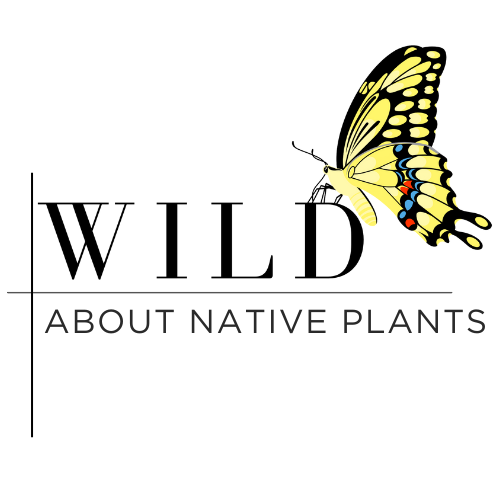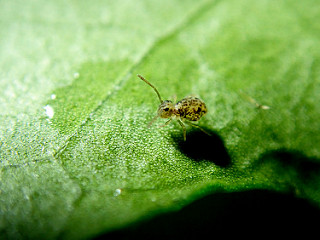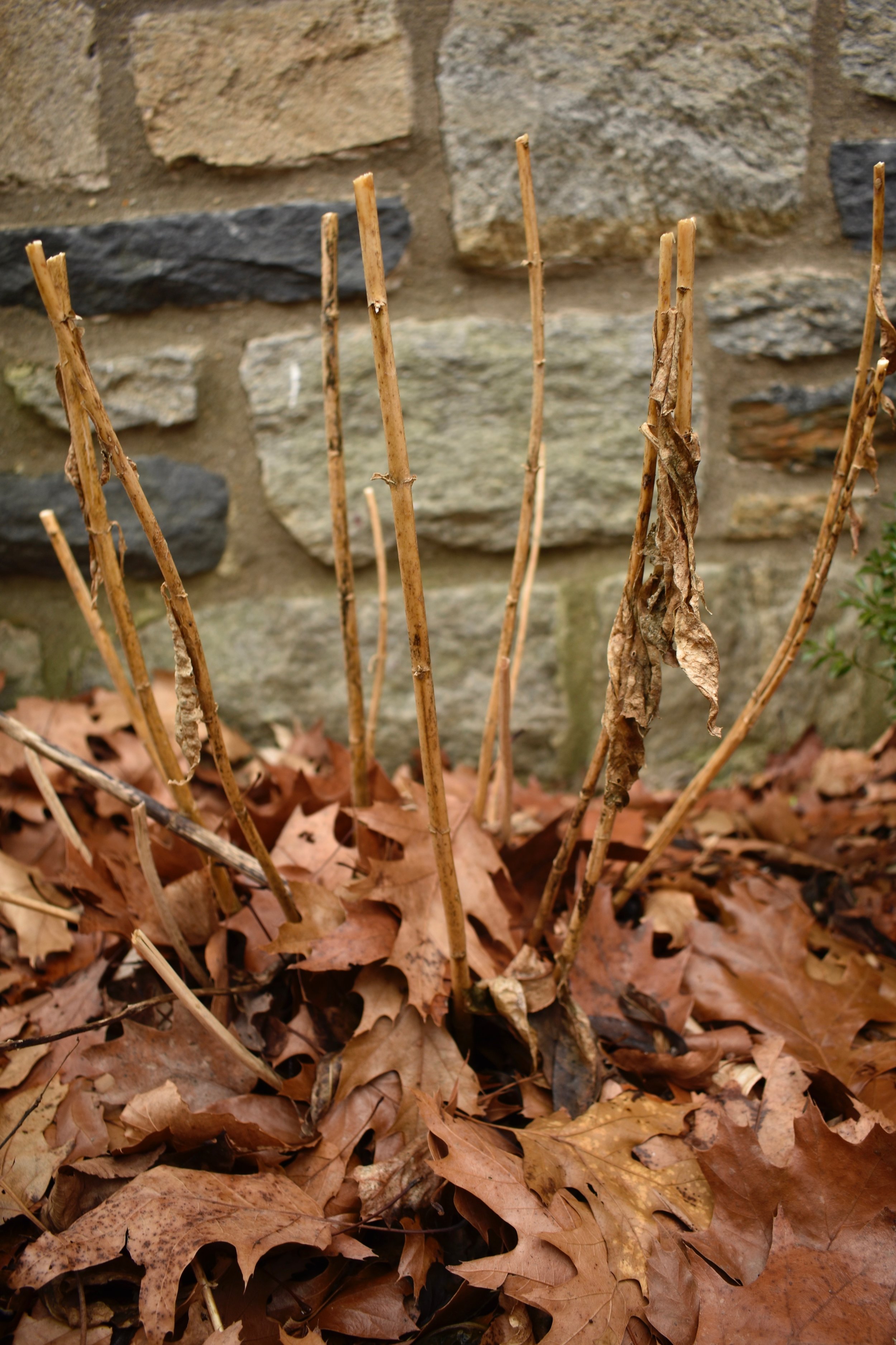Supporting Invertebrate life in Modern Times
Reach down and pick up a handful of soil, like you did when you were a kid. Run it through your fingers as you contemplate its essence.
Just don’t squish the springtails!
Springtails are tiny but essential invertebrates that create healthy soil.
In fact, you might consider thanking these microscopic invertebrates for the existence of the soil in your hand, that stuff of childhood memories and necessary ingredient in the recipe of earthly life. Springtails were the first terrestrial organisms on Earth. Their droppings—created by eating moss and algae after glaciation—created the substrate by which most plants grow. They eat decaying vegetation, fungus and bacteria, and serve as a critical food source for soil predators.
Easily overlooked by human eyes, tiny invertebrates like springtails create functional ecosystems where decaying organic matter is returned to the soil as nutrients for growing vegetation. As plants then absorb the sun’s energy—and create organic matter through photosynthesis—insects like caterpillars eat the leaves, transferring this absorbed energy up through the food web to other insects, amphibians, birds and mammals.
In addition to creating soil and capturing the sun’s energy, invertebrates large and small provide other ecosystem services including pollination to ensure a diverse human food supply and reproduction of wild plants. We rely on them almost unknowingly and often without respect given the magnitude of their importance.
In his 1987 article “The Little Things That Run the World”, famed naturalist (and my inspiration!) E.O. Wilson reminded us of the sheer numbers and importance of invertebrates.
“...if invertebrates were to disappear, I doubt that the human species could last more than a few months. Most of the fishes, amphibians, birds, and mammals would crash to extinction about the same time. Next would go the bulk of the flowering plants and with them the physical structure of the majority of the forests and other terrestrial habitats of the world.”
Edward O. Wilson, Pulitzer Prize-winning naturalist and world’s expert on ants reminds us of the integral importance of the “little things”. Photo source: Wikimedia Commons
Despite their indispensable role in the environment, recent studies have revealed the decline of invertebrates around the globe. The 2010 International Firefly Symposium revealed that fireflies were declining due to habitat loss and degradation, over-collection and pesticides. The International Union for Conservation of Nature (IUCN) has recorded a 35% drop in 40 years of butterflies and moths and a 45% decline in total invertebrate species studied worldwide. A recent New York Times article, “The Insect Apocalypse is Here” details widespread insect casualties including the 75% loss in the biomass of flying insects in German nature preserves over 27 years and what it could mean for life on earth.
We’re beginning to understand that climate change and subsequent warming of the earth’s surface will be responsible for extinction of some of our landbirds, insects and other arthropods, but human-caused losses of animal species are most immediately obvious in habitat destruction and degradation from development and commercial agriculture. Scientists have coined the term anthropocene defaunation to describe this phenomenon, an apt analogy to “deforestation”.
Awareness of the loss of species biodiversity inspires a series of potentially uncomfortable but relevant questions?
Given the amount of land that we’ve taken from non-human creatures, is it time to change course? Are we careful not to use herbicides and pesticides given their already widespread over-use in agriculture? Have we come to know and appreciate the native trees and other plants in our yards, learning about their functionality in feeding the insects and birds? Are we learning the names and habits of invasive species in our area and helping to eliminate them on our properties and beyond? Are we aware of the wildlife value of the plants in our landscape designs? Do we have the courage to defy traditional horticultural practices and neighborhood norms, leaving leaves and dead wood for invertebrate species? Are we protecting natural habitat and restoring refuge in ecologically barren areas of our public and private spaces?
Stewarding our landscapes in the modern era certainly requires mindfulness. After pondering these questions, consider the following.
Starter guide to supporting invertebrates in the modern era
Plant native plants - Food for all!
In the disturbed and developed land around human spaces, installing native vegetation as food and housing for our insect friends is an easy first step towards environmental stewardship. Many of the non-native plants that are typical in landscapes today do not serve native insects. Butterfly caterpillars simply cannot digest the leaves of Norway or Japanese maples, boxwoods or non-native azaleas and non-native viburnums. They didn’t evolve together, and the leaf chemistry is all wrong.
While traditional in landscape designs and nursery centers, non-native plants host almost no native insects. Native oak trees on the other hand support 500 species of caterpillars which provide the rich insect protein that birds require to raise their young. Small holes in native plant leaves mean your landscape is alive and serving a broad range of species.
Native oaks are our most ecologically valuable trees. Supporting over 500 species of butterflies and moths, these majestic beauties provide the nutrition required by baby birds and many other wildlife species. Non-native trees like Japanese and Norway maples can’t support insect species because they did not evolve together. Leaf chemistry determines whether a caterpillar can digest a leaf.
Armed with the science of insect and host plant relationships, we can select plants for our spaces that are more valuable as baby insect and baby bird food than many of the plants traditionally available to us in the horticultural trade...and we can make a difference together rapidly. The insects and birds will find us in no time. The more native species that I introduce into my space, the more butterfly and bird species I see every year.
This adorable ruby-crowned kinglet started to visit my garden when I let the asters and goldenrods grow as they pleased along the fence. I watched her enthusiastically hunt for hidden invertebrates…caterpillars, beetles, aphids, spiders and more. Goldenrods and asters are top picks as host plants for caterpillar larvae as well as nectar sources for adults.
Wild bergamot (Monarda fistulosa) is an excellent nectar plant for pollinators including butterflies, moths, bumble bees, digger bees, long-horned bees and leafcutter bees..
To support the greatest number of pollinators, include flowering native species in your landscape from early spring to fall. Early bloomers help spring-emerging bees and flies while mid-summer and fall-flowering plants serve later bee species, wasps, butterflies and moths. Check out this list of native plants for pollinators from bee specialist Heather Holm that includes floral bloom time as well as pollinator preference. Note that including different flower shapes will appeal to different pollinators. Bees with long tongues like our native bumble bees are suited for foraging on the long flowers of blueberries and monarda. Bees with shorter tongues like mining bees prefer the easily accessible flower nectar in boneset and sunflowers. In addition to floral diversity, consider planting a few plants of every species to ensure a sufficiency of nectar. Many bees for example will forage in a small area on the same flower species before returning to the nest. Visit Heather Holm’s website for more native plant lists to support native bees in all sun and soil moisture conditions.
Be sure to choose plants for both their nectar value for adult pollinators as well as their value as a food source for larval stages. Some plants serve both functions. See Prairie Nursery’s list of larval host plants for butterflies and moths. Search the Illinois Wildflowers website for faunal associations listing insects and other wildlife that use each plant species. Also, check out this guide on selecting plants for pollinators in the Eastern broadleaf forest. The National Wildlife Federation maintains a native plant finder database searchable by zipcode that reveals the most valuable wildlife perennials, trees and shrubs in your area based on the number of caterpillars that can use the leaves. I just learned that our native strawberry, Fragaria virginiana—a great ground cover for well-drained areas in sun to part-sun—hosts 77 species of butterflies and moths! Goldenrods and asters are the only perennials to out-do their host value.
In making plant selections, include trees, shrubs and perennials (including groundcovers), and don’t forget native grasses. Clump forming and wind-pollinated, grasses are loved by beetles and skippers, and they add functional diversity and beauty to your landscape.
Native foundation plantings can be beautiful and ecologically functional. I converted mine from non-native roses and invasive lilies to native shrub and perennial species that provide food and habitat for insects and birds. Native asters, liatris and more mix with winterberry holly, inkberry holly and fothergilla shrubs providing larval food for young insects and nectar plants for adult butterflies and moths.
Maintaining your landscape for the little things
Leave the leaves for butterflies
While some butterfly species migrate to the south or southwest, many butterfly and moth species overwinter in our area. Some like the Eastern tailed blue butterfly overwinter as eggs on leaves. Skippers and others hibernate as caterpillars buried in the soil under the leaves of their host plant or curled tightly in the host leaf (viceroys). Many swallowtails hibernate in the chrysalis stage on tree bark or stems, and the mourning cloak butterfly hibernates as an adult tucked away in crevices. Remember to leave whole leaves in your landscape because butterflies might be on or under them! If you must remove leaves from grassy areas, consider placing them nearby under shrubs or trees.
I use leaves as mulch in the winter because butterfly eggs or pupa could be overwintering on them. Since butterfly larvae could also be snugly buried in the soil beneath the leaves, I leave them until spring when I might gently rake some off to allow budding perennials more sun. I think they provide a beautiful contrast with the lawn, and I appreciate their weed-suppressing assistance.
Cut some of your perennial stems to 15” in spring to provide nesting sites for native bees. They will lay eggs in the hollowed out tubes. This photo shows the stems of summer phlox (Phlox paniculata). Elderberry, ironweed, blackberry and raspberry also sport pithy stems favored by some native bees.
Provide nesting sites for native bees
We have thousands of native bee species and different nesting habits among them. To provide nesting sites for small carpenter and yellow-faced bees, cut perennial plant stems back to 15” tall in spring. Also, leave dead wood lying on the ground for leaf cutter and mason bees. Ground nesting bees such as mining, cellophane, digger and sweat bees appreciate open soil in sunny, well-drained areas for nesting.
Give them all a drink
Consider creating a water source on your property if you don’t already have one. Click here for a guide to creating a natural pond without pumps or fish. These ponds are a great way to support our beloved dragonflies, natural predators of mosquitoes. Also, check out the Xerces Society pond habitat guidelines.
Be kind to the soil
Remember the springtails? Consider the living nature of your soil when stewarding your space. Move away from using herbicides, pesticides, road salt and chemical fertilizers which kill essential life in the soil and eventually runoff into streams and rivers. When preparing to plant, do not alter the structure of the soil by tilling or working wet ground, and do not amend soil before planting. Pick appropriate plants for your site conditions, and let nature do the rest.
Remove invasive plants
Did you know that the leaves of some invasive plants change the chemistry of the soil beneath them? The invasive Amur cork tree for example alters soil chemistry preventing the regeneration of our native oaks. Monocultures of Amur cork grow in the Philadelphia suburbs , clearly altering the course of natural tree communities.
Studies in the Georgia Piedmont have shown that the soil in areas with invasive Chinese privet shrubs (Ligustrum sinense) contains more invasive jumping worms than soils without privet infestation. Jumping worms outcompete native earthworms, rapidly eating organic matter in the upper forest floor causing vital nutrients to run off too quickly. They are unfortunately changing the composition of our forests, and researchers are worried about the effects on the regeneration of native trees and other plants as well as effects on soil invertebrates. Non-native plants often increase the pH and nitrogen content of the soil, both unfavorable to the growth of native forest species. The study revealed good news too however. Native earthworms returned to plots where privet was removed!
The evergreen shrub seen here invading the edge of a stream is one of the many invasive privet (Ligustrum) species commonly used in home landscaping. Spread by the birds, privet has wildly escaped into natural spaces across the southern and eastern United States. Do not plant this shrub, and remove the ones you might already have. Natural spaces like this one require stewardship by educated land owners to restore native habitat.
Non-native plants—invasive or not—can also harbor non-native, invasive insects that damage or kill our native plants and reduce habitat for the invertebrates they support. The spotted lanternfly is a case in point. This invasive leafhopper preferentially overwinters in the non-native Tree-of-Heaven (Alianthus altissima), and emerges in spring to damage not only fruit trees but also our native maples, oaks, cherries, birch, beech and many more. We sowed the seeds of disaster when the fast-growing Tree-of-Heaven was introduced into Philadelphia in 1784 as an ornamental shade tree. Multiple reintroductions and intentional plantings created the beginnings of its eventual escape into available openings everywhere. The damage assessment is yet to come as the lanternfly spreads far and wide.
The bottom line…Help to maintain natural soil chemistry in your landscape by removing invasive plant species. They not only take valuable above and below ground space that could otherwise provide functional habitat, but they also have the potential to harbor invasive insects and alter soil chemistry at the expense of native plant germination and soil life.
Call to action
Because private property now occupies the majority of land east of the Mississippi, nature preserves alone are not enough to protect all animal species. We can and should share our private spaces with sympathy towards the needs of invertebrates, all the while enjoying their magnificent company. In an era of climate change where species are forced to move in order to adapt to changing conditions, our gardens can provide needed refuge, saving species that might not otherwise survive. An added environmental benefit of our trees and plants is their sequestration of atmospheric carbon dioxide—plunging it into the soil where it can more slowly dissipate. The deep roots of our native plants will also better hold soil and absorb runoff to protect streams and water supplies.
Reading or re-reading entomologist, Doug Tallamy’s book is a great way to get inspired about the importance of native plants for native insects.
“Gardens and the greater landscapes that surround them occupy such enormous areas of the country that they have great potential to address many of the environmental challenges facing us today if given half a chance. Gardens are made of plants and plants deliver, either directly or indirectly, many of the ecosystem services that support human populations. Landscape designers, landscape architects, gardeners, and even homeowners who have no interest in gardening have within their power the ability to protect our watersheds, cool and clean the air we breath, build and stabilize top-soil, moderate extreme weather, sequester carbon, and protect the biodiversity that drives ecosystem function.”
By taking care of invertebrates, we also take care of the birds, mammals and amphibians that create a healthy and functional ecosystem. The benefits of taking our landscapes more seriously could change the world for the better—and the more properties that we create with lush and functional habitat, the more we can support the nature which has given us life. Let’s continue the effort and enjoy every minute!
——————-
Springtail photo credit: Bugldy99 <a href="http://www.flickr.com/photos/130637544@N02/45475682774">Ptenothrix maculosa ssp. olympia principal form</a> via <a href="http://photopin.com">photopin</a> <a href="https://creativecommons.org/licenses/by-nc/2.0/">(license)</a>










